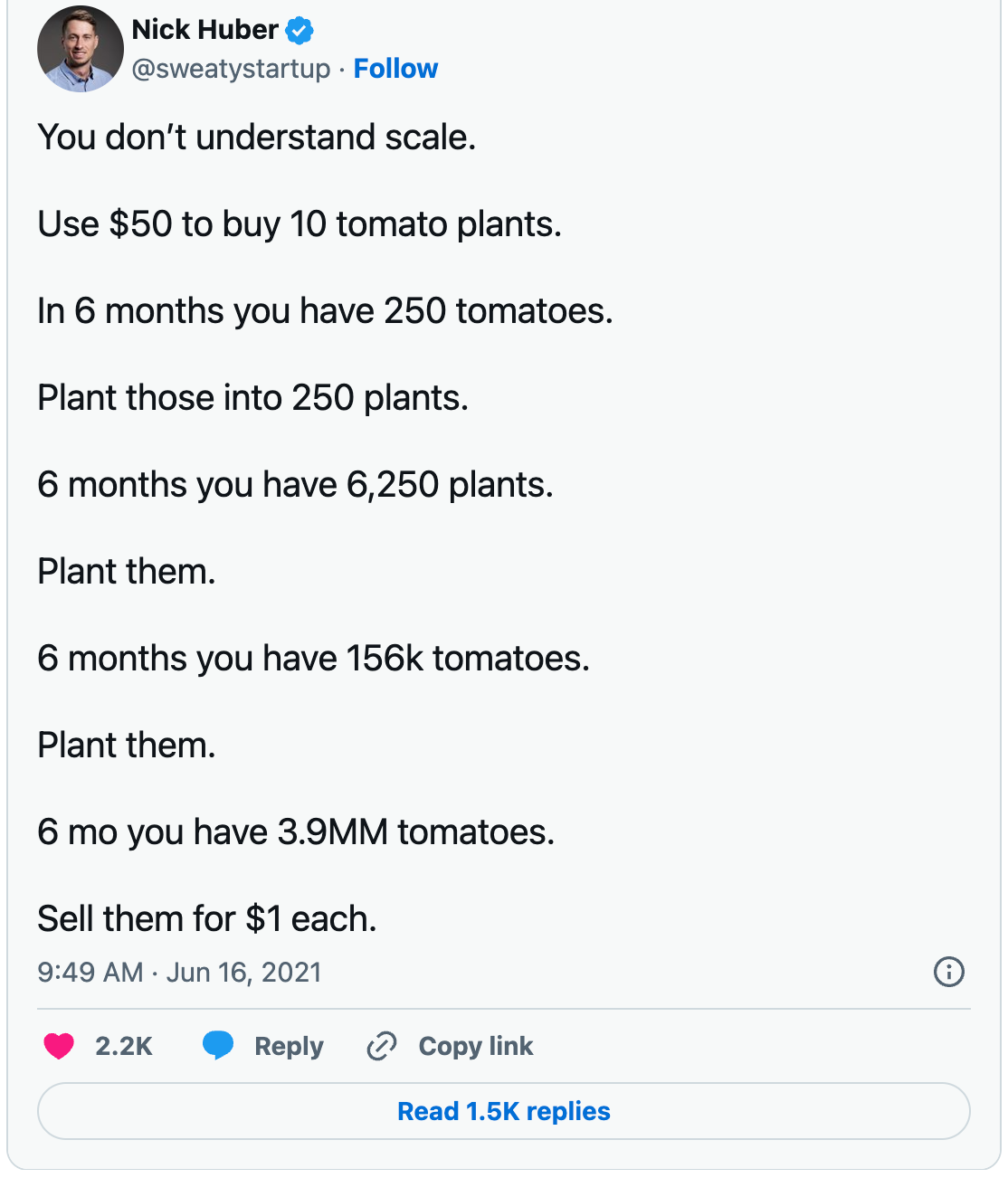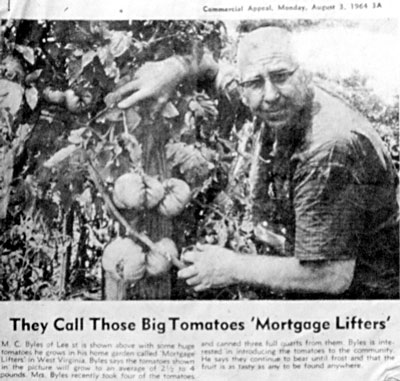The Mortgage Lifter Tomato
A baby's ear syringe, a mountain of broken trucks, and the unlikeliest tomato breeder in history.
The country around Logan in West Virginia begets giants, regurgitations of men heaved forth by the black coal-stained heart of those hills. And these giants, well, they tend to get fidgety. Devil Anse Hatfield carved a timber empire from the wilderness before deciding that what his corner of Appalachia lacked was a family feud. There was Jack Dempsey, who fought his way out of the mountains to become heavyweight champion of the world. And last came M.C. Byles, who looked the Great Depression square in the face and decided what America needed was a better tomato.
I never been to school a day in my life but anything I wanted to do, I done it.
— M.C. Byles
The first quarter of the 20th century saw a stream of trucks grinding through the steep hills of southern West Virginia, bearing timber and coal to feed the industrial hunger of the nation. The grade up one particular mountain outside Logan tended to break a machine like an old cowboy with an ornery colt. First came the steaming and hissing radiator, then the seizing engine, and finally the slow roll back down the hill. At the bottom sat MC Byles’ repair shop. Byles lived a number of lives during his 97 years, but the name that stuck with him was Radiator Charlie.
Radiator Charlie’s education began at age four, not in a schoolhouse but in North Carolina’s cotton fields, when his mother dragged him out from under the porch one morning and told him he was going to work. I'm too little to work! he protested, ever the optimist. His mother answered: No you are not. So he picked cotton.1
Like many men of his era, Byles collected careers the way millennials collect houseplants and therapists (perhaps filling the same void). He joined the National Guard and discovered a talent for wrestling at a time when the sport still straddled the line between spectacle and combat. Decades before the pageantry of Hulk Hogan and Randy Savage, showmen in carnival tents at county fairs offered a dollar a minute to any local brave enough to step into the ring. Byles became a barnstormer, traveling the dirt roads of Appalachia to grapple with carnies in the WWE’s ancestral swamp.
Some matches had the unscripted violence of Tyson taking a bite out of Holyfield, others were as precisely engineered as a Huberman supplement stack. Real or staged, a dollar was a dollar - a principle that has endured long enough to turn the baddest man on the planet into a pissant YouTuber’s $20 million punching bag2. Where Byles fell on the spectrum between theater and authentic brawling is lost to history — his only comment on his fighting career: I never lost but a few times.
But Byles was a manifestation of that strange roving American archetype compelled to reinvent himself as well as machines, a first rate shade-tree mechanic and junkyard alchemist distilling automata from a blend of motor oil and cheap beer. He created a new garden tiller that he never bothered to patent, learned to pilot small planes and flew mail routes for awhile, then opened his fortuitously located repair shop. Well, I've always had a mind of doing things that nobody else couldn't do, he later recalled in an interview with his grandson. I never been to school a day in my life but anything I wanted to do, I done it.3
When the Great Depression descended and the coal trucks thinned, Byles got to pondering. True to form, he decided the solution to financial ruin was to breed a tomato so remarkable people would travel from all over to buy it. Armed with nothing but a baby's ear syringe and the four biggest tomatoes he could find in the region, he planted a German Johnson - a brandywine variety already pushing a pound per fruit - and ringed it with nine plants from his other chosen varieties in a vegetable séance. Each season he took his syringe, carefully transferred pollen from the outer circle to the German Johnson in the center, saved the seeds, and began again the next spring.
The result, after six years, was a tomato that sometimes tipped the scales at four pounds - the weight of a slightly underripe baby, which even Jonathan Swift might have found a bit much for a sandwich. Byles sold the plants for a dollar apiece - over twenty dollars in today's money - and Radiator Charlie's tomatoes quickly became legendary in Appalachia. People drove hundreds of miles to find them, in an era when such pilgrimages were typically reserved for fleeing dust bowls.
Within six more years, he'd paid off his mortgage and christened his tomato with a new name. I didn't pay but six thousand dollars for my home, he said, and paid most of it off with tomato plants.
The Mortgage Lifter might have remained Appalachian lore if not for Jeff McCormack, the founder of Southern Exposure Seed Exchange. In the mid-1980s, McCormack went on a road trip to buy a computer and ended up meeting Byles' granddaughter-in-law. Byles sold him some seeds, and suddenly his tomato was making its way into gardens across America, eventually earning a place on the Slow Food Ark of Taste.
As it turns out, Radiator Charlie wasn't the first person to figure that tomatoes could pay off a mortgage. Sixty miles north in Barboursville, William Estler's Mortgage Lifter predated Byles' experiments by more than a decade. And his family had the paperwork to prove it. At least they did at one time.
In the 1920s, while other Americans were distilling bathtub gin and chasing the stock market, William Estler was pursuing something more fundamental: the perfect low-acid tomato. What emerged from his garden was a botanical marvel that stretched twelve feet into the West Virginia sky, bearing big sweet fruits that his wife would eat for breakfast with sugar on top. Everyone else seemed to love them too, so he built a greenhouse and began selling them wholesale to local nurseries. A nursery employee suggested the name, and Estler took to it, copyrighting it in 1932.
The legacy eventually passed to his son Bob, who converted most of the family land to a nine-hole golf course to keep from having to sell it (the tomatoes had not in fact lifted the mortgage). But he carved out a corner for his father's tomatoes. Each year he planted exactly seventy-five plants and sent seeds to other gardeners. When a letter arrived from an acquaintance in Texas in 1987 mentioning a Radiator Charlie's Mortgage Lifter in the Southern Exposure Seed Exchange catalog, Bob was livid. He demanded the listing's removal, only to discover the copyright had lapsed in the 1970s — the family attorney had forgotten to renew it. But he kept growing, giving away seeds, and trying to spread the word about his father’s tomato until his death in 2012.
Today both varieties live on, West Virginia brothers sharing little but a name and a big beefsteak personality. They’re both relatively easy to find in seed catalogs (although Radiator Charlie’s gets more ink)4, along with a number of other Mortgage Lifters that have emerged over the years. There's the Halladay from Kentucky, the Watson from Illinois, the Mullens from another corner of West Virginia - as if the dream of escaping debt through better vegetables was somehow bred into the American spirit.
These days the mortgages have gotten bigger, the tomatoes have remained the same size, the spirit persists, and the understanding of basic botany has declined.

Over here my three year old is campaigning to have ice cream for breakfast as we sit in the wake of Thanksgiving. Times change.
I’m talking, of course, about the absurd Jake Paul Mike Tyson Netflix debacle.
A Public Radio segment from Living on Earth.
Radiator Charlie’s Mortgage Lifter, from Southern Exposure Seed Exchange
Estler’s Mortage Lifter, from The Seedstead





